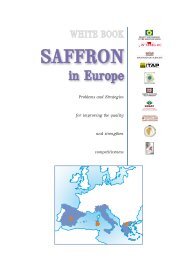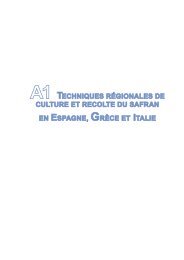Annex White book.pdf
Annex White book.pdf
Annex White book.pdf
Create successful ePaper yourself
Turn your PDF publications into a flip-book with our unique Google optimized e-Paper software.
In case of interferences at the final chromatogram due to high crotecineesters concentration, an alternative centrifugal procedure is possibleas suggested by Spain. Upon completion of the centrifugation as describedabove, the supernate liquid is placed in a sediment glass whereacid sulphate at 98% is added in order to reach a pH value of 1 pH. Theremaining solution is heated at 100oC for about 30 minutes (in waterbath) and then placed in a centrifugal tube for one more centrifugationat 4000 rounds per minute for 5 minutes. The supernatant is placed ina different sediment glass in order to raise its pH value to 2pH with thehelp of 40% of sodium hydroxide. The solution is centrifuged again at4000 rounds per minute for 5 more minutes.Separation of the dye substancesAt this phase, we use solid polyamide extraction cartridges (SPE).The cartridges are filled with 10 ml of water. The saffron extract, describedabove, passes through the cartridge. The cartridge is washedmany times with 45 ml of methanol, 45 ml of acetone and again with45 ml of methanol treated with 500 μl of formic acid in constant flowof 6 to 8 ml/minute. In case of applying the alternative centrifugationprocedure based on acetification and transformation of the extract intoa base, the reagent could be 10 ml instead of 45 ml.The dye substances are separated from the polyamide column with10 ml of methanol/ammonium solution (95/5) directly into a roundcontainer that is connected to a rotary evaporator, where the solvent isremoved in vacuum temperature less than 40oC. The residue is dilutedagain in 300 ml of water. It is then filtered with a polytetrafluoroethylene(PTFE) filter with a 45 μm pore diameter. 50 μl are injected into thechromatography apparatus.Chromatographic conditions:Column: C18, length: 150 mm, inner diameter 4,6 mm, particlesize: 3 μmMoving phase flow: 0,8 ml/minuteColumn temperature: 30 o CSolvents:Phase A: 900 ml of water are added to 1,36 g of acid phosphoric bipotash.Using potash hydroxide 1M we raise the pH value to 7pH andfill the solution with 1 lit of water up to the mark.Phase B: methanol (HPLC quality)Phase C: acetonitrile (HPLC quality)164




